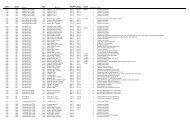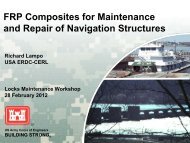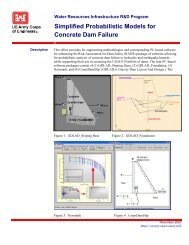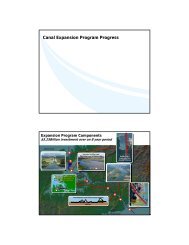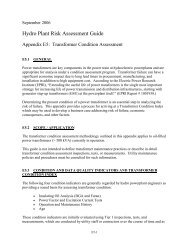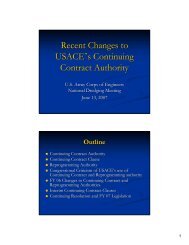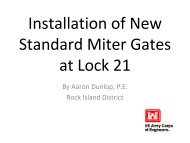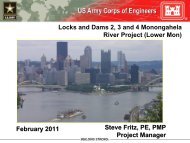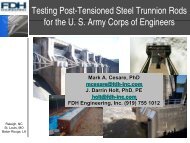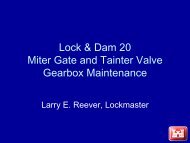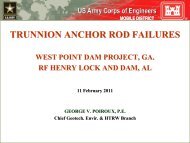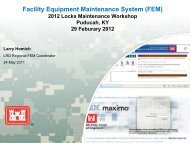Hydro Plant Risk Assessment Guide
Hydro Plant Risk Assessment Guide
Hydro Plant Risk Assessment Guide
You also want an ePaper? Increase the reach of your titles
YUMPU automatically turns print PDFs into web optimized ePapers that Google loves.
• No abnormal noises.<br />
• No leaks of hydraulic oil or lube oil.<br />
• Does the backup power system for the emergency closure function<br />
• Does the gate/valve drift in any position (This assumes it is not latched or dogged.)<br />
• Has the opening or closing pressures (on hydraulic systems) changed from baseline<br />
Qualified personnel should make a subjective determination of scoring that encompasses as<br />
many factors as possible under this indicator. Results are analyzed and applied to Table 7 to<br />
arrive at an appropriate Operations History Condition Indicator Score.<br />
Table 7 – Operations History Scoring<br />
Results<br />
Meets original operational criteria, tested as required, no known<br />
design and operational deficiencies.<br />
System is functional, but may not meet all operating criteria. Tests as<br />
required have been performed. No known design deficiencies.<br />
Does not meet original operational criteria or not tested as required or<br />
has a known design and operational deficiency.<br />
Operations Condition<br />
Indicator Score<br />
2<br />
1<br />
0<br />
Condition Indicator 5 – Maintenance History<br />
This condition indicator only addresses the amount of maintenance that the system currently<br />
requires. A lack of maintenance will be reflected in the Condition Indicator for Physical<br />
Condition. The Maintenance Indicator is broken into the following 3 categories:<br />
• Small – It is assumed that a small amount of routine annual preventative maintenance is<br />
required for every gate or valve.<br />
• Moderate – Moderate (normal) levels of maintenance would include some corrective<br />
maintenance.<br />
• Excessive – Excessive maintenance is intended to include labor-intensive items.<br />
Frequent corrosion repairs or abnormal wear to components would be considered<br />
excessive.<br />
Results are analyzed and applied to Table 8 to arrive at an appropriate Maintenance History<br />
Condition Indicator Score.<br />
Table 8 – Maintenance History Scoring<br />
Maintenance Condition<br />
Amount of Required Maintenance<br />
Indicator Index Score<br />
Small 2<br />
Moderate 1<br />
Excessive 0<br />
E11-12



